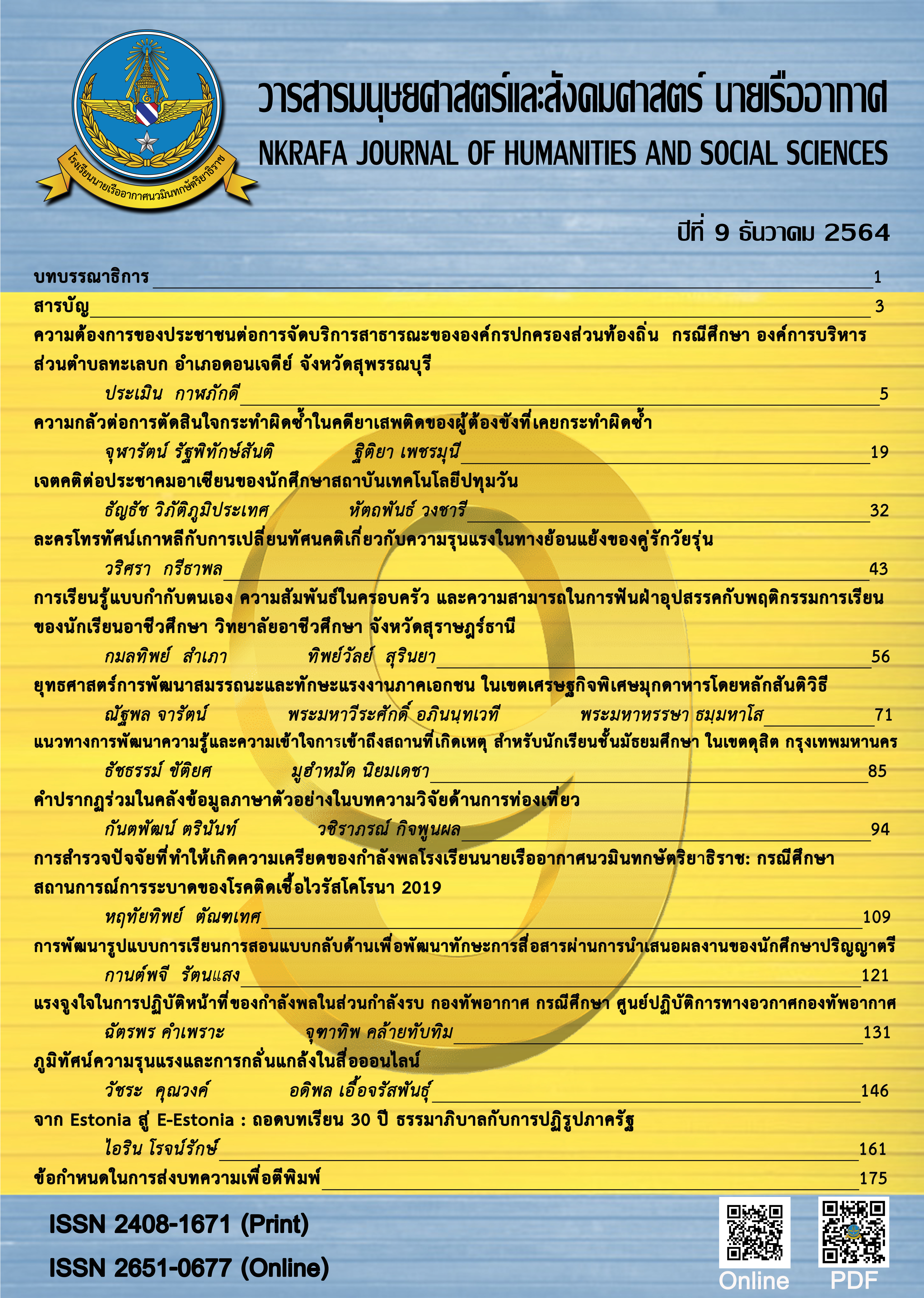Landscape of Violence and Cyberbullying
Main Article Content
Abstract
The purpose of this academic paper is to study the violence of cyberbullying and how to deal with online changes. As a public sphere in social network. Nowadays, online media has been greatly developed and online media has become a part of Thai people's way of life. Public sphere in social network has resulted in the use of space for social activities as if bringing the real world into the Internet. This makes the time and distance constraints lessened communication It is also an area where people get a two-way involvement, both as a receiver and a messenger. Public sphere in social network is free of communication as they can hide their real names from the real identity of users. These things lead to freedom of expression that happens either intentionally or unintentionally. These comments have damaged the relationships among users in the same area with both face-to-face and group conflicts, creating a new kind of violence in which the outcome is more psychological than the harm external bodies, as people are not required to have one-on-one confrontations in this public sphere in social network. The results of the study on online violence and cyberbullying were caused by users with disregard for ethics and authenticity due to the wide variety of online messages sent in public areas, including the anonymity. Communication thus leads to freedom of expression that exceeds the initial aim of creating public sphere social in network. Commenting has resulted in conflicts or cyberbullying and has become a widespread social issue. It affects both the action and the victim and those around it. Users should take into account that is 1. Learn and be aware of the use of the online world. 2. Understand the difference between people in the online world. 3.Access the online world as necessary and balance your online time and the real world. 4. Focus on the substance you want to convey. The public sphere in social network represents the thoughts of people in society that reflect the society in which technology is a medium of life. When an event occurs in the online media space, it is considered a lesson both for good and for bad.
Article Details
บทความที่ได้รับการตีพิมพ์เป็นลิขสิทธิ์ของวารสารมนุษยศาสตร์และสังคมศาสตร์ นายเรืออากาศ
ข้อความที่ปรากฎในบทความแต่ละเรื่องในวารสารวิชาการเล่มนี้ เป็นความคิดเห็นส่วนตัวของผู้เขียนแต่ละท่าน ไม่เกี่ยวข้องกับโรงเรียนนายเรืออากาศฯ และคณาจารย์ท่านอื่น ๆในโรงเรียนนายเรืออากาศฯ แต่อย่างใด ความรับผิดชอบขององค์ประกอบทั้งหมดของบทความแต่ละเรื่องเป็นของผู้เขียนแต่ละท่าน หากมีความผิดพลาดใด ๆ ผู้เขียนแต่ละท่านจะรับผิดชอบบทความของตนเองแต่เพียงผู้เดียว
References
พรภัทรา ภาณุนันทน์, “สื่อสังคมออนไลน์กับการเป็นพื้นที่สาธารณะในสังคมไทย”, วิทยานิพนธ์ปริญญามหาบัณฑิต, สาขาเศรษฐศาสตร์การเมือง, คณะเศรษฐศาสตร์, จุฬาลงกรณ์มหาวิทยาลัย, 2561.
We are social, “Digital2020Thailand (january2020),” [Online]. Available: https://www.slideshare.net/ DataReportal/digital-2020-thailand-january-2020-v01. [Accessed: December 22, 2020].
ชนิษฏา กลีบยี่สุ่น, “พฤติกรรมการใช้สื่อออนไลน์ในการเข้าถึงข้อมูลด้านศัลยกรรมความงามของผู้บริโภค”, วิทยานิพนธ์ปริญญามหาบัณฑิต, สาขานโยบายและการบริหารเทคโนโลยีสารสนเทศ, วิทยาลัยนวัตกรรม, มหาวิทยาลัยธรรมศาสตร์, 2561.
ไอลอว์ I Law Freedom, “เสรีภาพการแสดงออก เสรีภาพของทุกคน,” [Online]. Available: https://freedom.ilaw.or.th/freedom-of-expression-101/concept-and-history, [Accessed: 21 ธันวาคม 2563].
ภาสกร จิตรใคร่ครวญ, “เทคโนโลยีของสื่อใหม่และการนำเสนอตัวตนต่อสังคมกับพฤติกรรมการสื่อสารบนเครือข่ายสังคมออนไลน์”, วิทยานิพนธ์ปริญญามหาบัณฑิต, สาขาการประชาสัมพันธ์, คณะนิเทศศาสตร์, จุฬาลงกรณ์มหาวิทยาลัย, 2553.
ดีเทค Dtac, “คำด่าไหนฝังใจที่สุด,” [Online]. Available: https://www.iphone-droid.net/dtac-stop-cyber-bullying-day/. [Accessed: 21 ธันวาคม 2563].
Droidsans, “ผลวิจัยคนไทยมักล้อเลียนเรื่องรูปลักษณ์และเพศในโลกออนไลน์,” [Online]. Available: https://droidsans.com/stop-cyber-bullying-campaign/. [Accessed: 21 ธันวาคม 2020].
สุภาวดี เจริญวานิช, “การรังแกกันผ่านพื้นที่ไซเบอร์: ผลกระทบและการป้องกันในวัยรุ่น,” วารสารวิทยาศาสตร์และเทคโนโลยี ปีที่ 25, ฉบับที่ 4, กรกฎาคม-สิงหาคม 2560, หน้า 639-648, [Online]. Available: https://li01.tci-thaijo.org/index.php/tstj/article/view/75170. [Accessed: 20 ธันวาคม 2563].
ณัฐรัชต์ สาเมาะและคณะ, “การรับรู้ของเยาวชนต่อการรังแกในพื้นที่ไซเบอร์,” วารสารพฤติกรรมศาสตร์เพื่อการพัฒนา, ปีที่ 6, ฉบับที่ 1, มกราคม 2557, หน้า 351-363, [Online]. Available: https://so02.tci- thaijo.org/index.php/JBSD/article/view/16008/14578. [Accessed: 20 ธันวาคม 2563].
ภาณุรัตน์ มาจันทร์, “กระบวนการตรวจสอบพิจารณาตนเอง (Self-censorship) เกี่ยวกับความรุนแรงของผู้ผลิตละครโทรทัศน์ไทย”, วิทยานิพนธ์ปริญญามหาบัณฑิต, สาขาสื่อสารมวลชน, คณะวารสารศาสตร์และสื่อสารมวลชน, มหาวิทยาลัยธรรมศาสตร์, 2556.
พรชนก ดาวประดับ, “รูปแบบและลักษณะการมีส่วนร่วมในการกลั่นแกล้งบนพื้นที่สาธารณะออนไลน์”, วิทยานิพนธ์ปริญญามหาบัณฑิต, สาขาสื่อสารมวลชน, คณะวารสารศาสตร์และสื่อสารมวลชน, มหาวิทยาลัยธรรมศาสตร์, 2560.
ธณัศมนต์ จั้นอรัญ, “การรับรองและคุ้มครองสิทธิในความเป็นอยู่ส่วนตัวของผู้ข่มเหงรังแกบนไซเบอร์”, วิทยานิพนธ์ปริญญามหาบัณฑิต, สาขานิติศาสตร์, คณะนิติศาสตร์, จุฬาลงกรณ์มหาวิทยาลัย, 2560.
ไทยรัฐออนไลน์, “โซเชียลรุมบูลลี่ซ้ำหลังหญิงสาวเปิดเผยเหตุละเมิดทางเพศในโรงเรียนระบุแค่อยากเห็นเด็กปลอดภัย,” [Online]. Available: https://www.thairath.co.th/news/local/bangkok/1981427. [Accessed: 21 ธันวาคม 2563].
บางกอกอินไซด์, “3ดาราสาวแจ้งจับโรคจิตทักแชท,” [Online]. Available: https://today.line.me/ th/v2/article/97n5Zx. [Accessed: 21 ธันวาคม 2563].
เรื่องเล่าเช้านี้, “สาวทอมเครียดถูกบูลลี่ทางโซเชียลยิงตัวตายเสียชีวิต” [Online]. Available: https://teroasia.com/news/152034?ref=news. 2562. [Accessed: 21 ธันวาคม 2563].
Droidsans, “ต้องทำอย่างไรเมื่อโดนคอมเมนต์แย่ๆหรือโดนบูลลี่ในโซเชียล,” [Online]. Available: https://droidsans.com/howto-handle-cyber-bullying/. [Accessed: 21 ธันวาคม 2020].


